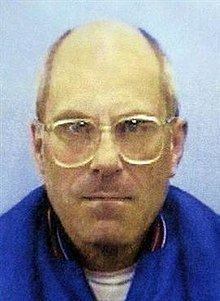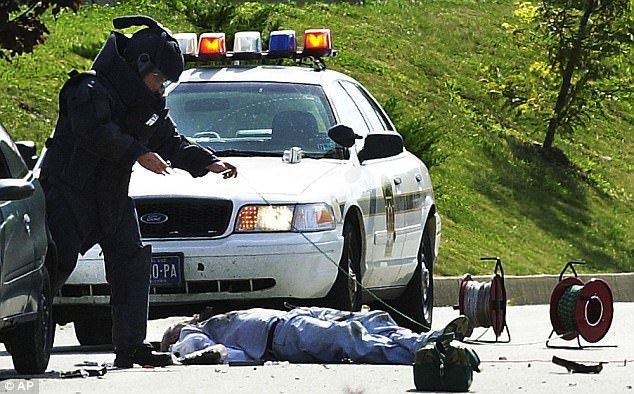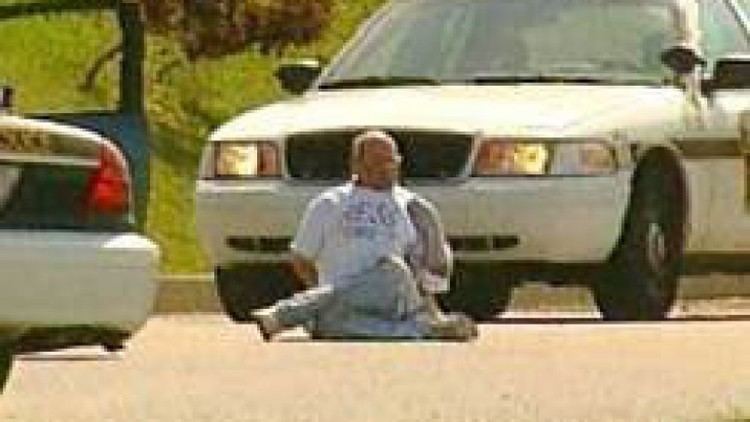Nationality American Music director The Love Machine Name Death Brian | Motive Bank robbery Occupation Pizza delivery man | |
 | ||
Full Name Brian Douglas Wells Born November 15, 1956 ( 1956-11-15 ) Cause of death Explosive device collared around neck Similar People Death of Garry Hoy, Kenneth Pinyan, Artie Butler, Mark Lindsay | ||
Brian Douglas Wells (November 15, 1956 – August 28, 2003) was an American pizza delivery man who was killed by a remotely controlled bomb fastened to his neck, under coercion from the maker of the bomb. After he was apprehended by the police for robbing a bank, the bomb was detonated. The bizarre affair was subject to much attention in the mass media.
Contents

In a July 2007 indictment, federal prosecutors alleged that Wells had been involved in the planning of the botched bank-robbery. Two of his alleged co-conspirators, Marjorie Diehl-Armstrong and Kenneth Barnes, were indicted by a federal grand jury on charges of bank robbery, conspiracy, and weapons charges. Kenneth Barnes subsequently pleaded guilty in September 2008 and largely confirmed that Wells was indeed involved in planning the robbery but also revealed Wells was under the impression an actual bomb would not be used. When he discovered the bomb was real, Barnes said a pistol was fired in order to force Wells' compliance, and witnesses confirmed hearing a gunshot. On December 4, 2008, U.S. District Judge Sean J. McLaughlin sentenced Barnes to 45 years in federal prison for his role in the bank robbery and use of a destructive device during a crime of violence. On November 1, 2010, Marjorie Diehl-Armstrong was found guilty of participating in the crime, and was sentenced to life plus 30 years on February 28, 2011.

The event
Wells dropped out of high school in 1973. For nearly 30 years, he worked as a pizza delivery man and was considered a valued and trusted employee of the Mama Mia Pizzeria in Erie, Pennsylvania. On the afternoon of August 28, 2003, Wells received a call to deliver two pizzas to 8631 Peach Street, an address a few miles from the pizzeria. It was later found that the address was that of the radio station WSEE-TV's transmission tower at the end of a dirt road.

According to law enforcement reports, Wells was allegedly meeting people he thought were his accomplices, including Barnes. Wells allegedly participated in the planning for the robbery, and he had been told the bomb was going to be fake. Furthermore, he was to claim that three black men had forced the bomb on him and were holding him as a hostage.

At the television tower, Wells learned that the device was real. He wrestled with the men (presumably Barnes and William A. Rothstein) and tried to flee, but one of them fired a gun, causing Wells to stop. It was at this Time that the collar bomb is assumed to have been attached. The culprits gave him a sophisticated home-made shotgun, which had the appearance of an unusually-shaped cane, and told him to use it if he encountered resistance at the bank. Wells then entered a bank with the shotgun and demanded $250,000. When police intervened, Wells claimed that three unnamed people had placed a bomb around his neck, provided him with the shotgun, and told him that he had to commit the robbery and several other tasks, lest they kill him.
At first, the police made no attempt to disarm the device. The bomb squad was first called at 3:04 PM, at least 30 minutes after the first 9-1-1 call. At 3:18 PM, just three minutes before the bomb squad arrived, the bomb detonated and blasted a fist-sized hole in Wells' chest, killing him. It is believed that Wells was killed by Diehl-Armstrong and her conspirators to reduce witnesses against herself and others. The event was broadcast on television and the footage subsequently found its way to video sharing sites.
A note found on Wells had instructions for him to carry out four tasks (the first of which was the bank robbery) in a set period of time before the bomb went off. Wells would gain extra time with the completion of each task. However, it was later determined that regardless of what had unfolded, Wells would never have had enough time to complete the tasks to get the bomb defused: police traveled the route on the note and couldn't complete it in the time the note allocated to Wells.
Wells was allegedly drawn into the plot through Barnes, whom he knew through Diehl-Armstrong. The plot was hatched to get funds to pay Barnes enough money to kill Diehl-Armstrong's father, so that Diehl-Armstrong would receive an inheritance, according to authorities. However, Wells had only stolen $8,702, far from the $125,000 needed for the killing. Furthermore, the inheritance Diehl-Armstrong reportedly coveted was ultimately denied to her. Her father's estate had once been valued near $2 million, but gifts to friends had lowered the value to less than $200,000 at his death. Additionally, his last will and testament left only $2,000 to Diehl-Armstrong, yet the estate's obligation to pay outstanding medical bills before inheritances meant she received nothing.
Aftermath
On September 20, William "Bill" Rothstein, who lived in a house near to the radio tower, called police to inform them of the body of a man, James Roden, hidden in a freezer in a garage and was immediately arrested. He claimed his ex-girlfriend, Marjorie Diehl-Armstrong, whom he had dated in the late 1960's and early 1970's, had murdered Roden (Diehl-Armstrong's then live-in boyfriend) during a dispute over money with a 12-gauge shotgun and contacted him to aid her in hiding the body. Rothstein claimed to have not been directly involved in the murder but could not bring himself to grind up the body and called the police out of fear of Diehl-Armstrong; the following day, she was arrested. In January 2005, Diehl-Armstrong plead guilty but mentally ill to the murder of Roden and was sentenced to seven to 20 years in prison. Rothstein died of lymphoma in July 2004 aged 60.
In April 2005, Diehl-Armstrong confined to a state trooper that she had information about the Wells' case and after meeting with FBI agents, said she would tell them everything she knew if she was transferred from Muncy State Penitentiary to a minimum-security prison in Cambridge Springs. During a series of interviews, Diehl-Armstrong admitted to providing the kitchen timers used for the bomb and said that Rothstein was the mastermind of the plot and that Wells had been directly involved in the plan. In late 2005, Kenneth Barnes, an ex-television repairman in jail on unrelated drug charges and friend of Diehl-Armstrong, was turned in by his brother-in-law after revealing details of the crime to him. Barnes told investigators that would tell them the whole story in return for a reduced sentence. He told them that Diehl-Armstrong was the mastermind of the crime and that she wanted the money to pay Barnes to kill her father, whom she believed was wasting her inheritance.
In July 2007, U.S. Attorney Mary Beth Buchanan announced the investigation was over and that Diehl-Armstrong and Barnes had been charged with crime, with Diehl-Armstrong as the mastermind. The deceased Rothstein and Wells were also indicted as conspirators to the crime. It was announced that Wells had been a part of the scheme from the beginning and had thought the bomb was fake and the instructions in his pocket were an alibi if he were to get caught. However, she revealed that Wells was betrayed by his conspirators and that he was fitted with a real bomb that would have exploded even if was removed.
On July 29, 2008, U.S. District Court Judge Sean J. McLaughlin made an initial finding that Marjorie Diehl-Armstrong was mentally incompetent to stand trial for the bombing due to a number of mental disorders, indicating that this ruling would be reviewed after Diehl-Armstrong had received a period of treatment in a mental hospital. She was then transferred for treatment in a federal prison mental health facility in Texas.
On September 3, 2008, Kenneth Barnes pleaded guilty to conspiring to rob a bank and to aiding and abetting. On December 3, 2008, Barnes was sentenced to 45 years in prison by a federal judge in Erie for his role in the crime.
On February 24, 2009, Judge McLaughlin scheduled a hearing for March 11, 2009, to determine if Marjorie Diehl-Armstrong was now competent to stand trial. Judge McLaughlin ruled Diehl-Armstrong incompetent to stand trial in July 2008. On September 9, 2009, the judge determined that she was indeed competent to stand trial. As of October 2010, Diehl-Armstrong's trial was underway in Erie, Pennsylvania and she had taken the stand to testify on her own behalf as part of her defense. She asked for a change of venue, arguing that extensive media coverage of the case prevented her from receiving a fair trial. Judge McLaughlin denied this request, noting that while the allegations were unusual "the [news] coverage as a whole has been about as factual and objective as it could be under the circumstances."
On November 1, 2010, Diehl-Armstrong was convicted of armed bank robbery, conspiracy to commit armed bank robbery, and of using a destructive device in a crime. She was sentenced to life plus 30 years on February 28, 2011. In November 2012 the Court of Appeals for the Third Circuit affirmed her conviction. In January 2013, the U.S. Supreme Court denied her petition for certiorari, declining to hear her case. In December 2015, Diehl-Armstrong lost a second appeal of her conviction. She died in prison of natural causes on April 4, 2017, at the age of 68, following a battle with breast cancer.
Media attention
The incident and the subsequent investigation were covered in American national media several times as the case continued to develop. When the story broke, many wrongly believed the incident to be terrorism-related. America's Most Wanted featured the story three times with newly-released evidence in hopes officials could gather new clues behind the case.
A collection of news articles that reported developments in the Brian Wells story was analyzed in a scientific study of information novelty.
The story was described in detail in the January 2011 issue of Wired magazine.
In 2012 Jerry Clark and Ed Palattella published Pizza Bomber: The Untold Story of America's Most Shocking Bank Robbery a true-crime book detailing the events.
